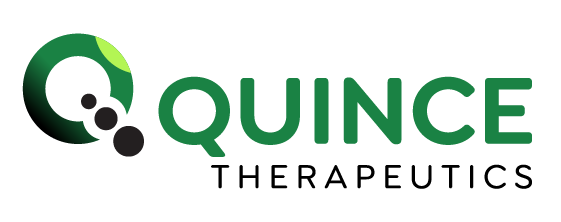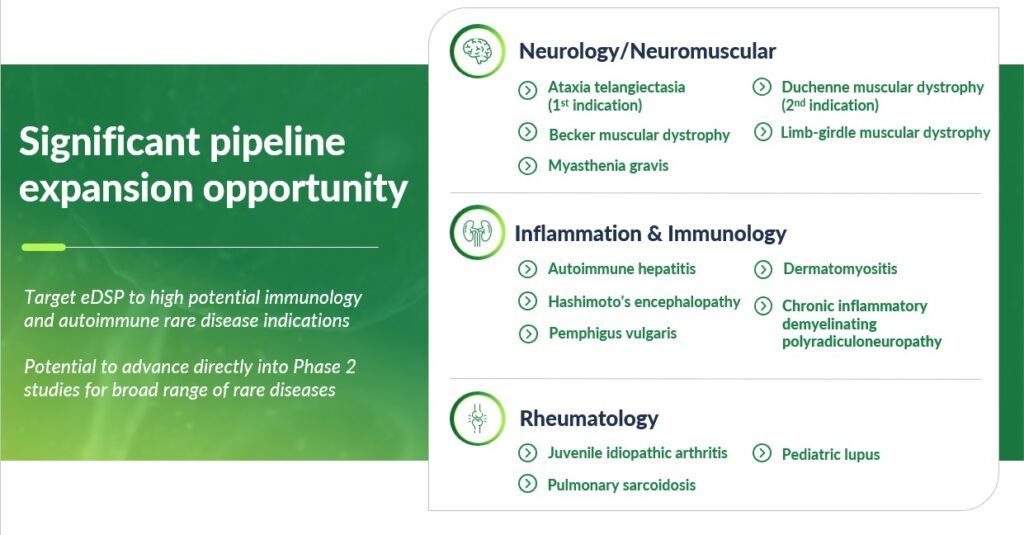eDSP (previously referred to as EryDex) is Quince’s first drug in development that leverages our AIDE technology and is composed of DSP encapsulated in autologous red blood cells. DSP is a corticosteroid well-described for its anti-inflammatory properties, but is coupled with serious adverse effects, including potential long-term adverse effects due to adrenal suppression. eDSP is designed to maintain the efficacy of corticosteroids while reducing or eliminating the significant adverse effects associated with corticosteroid treatment.
To date, there have been more than 7,800 infusions of eDSP in approximately 425 patients who received at least one eDSP treatment through participation in our sponsored clinical trials or expanded access programs. 188 patients have received eDSP treatment for at least 12 months — and many for several consecutive years — without toxicities well known to be associated with chronic corticosteroid use.
Based on many years of patients being treated monthly with eDSP, eDSP may minimize the long-term serious adverse effects that are a major impediment to the chronic administration of corticosteroids. Corticosteroid therapy without significant long-term safety liabilities would represent a major advancement in the potential treatment of many chronic diseases where corticosteroids are already known to be beneficial.
eDSP was previously evaluated in multiple early-stage investigator-initiated trials and clinical trials to evaluate safety and efficacy across a number of disease indications, including our lead indication Ataxia-Telangiectasia (A-T), as well as inflammatory bowel disease, including Crohn’s disease (CD) and ulcerative colitis (UC), chronic obstructive pulmonary disease (COPD), and cystic fibrosis (CF). These previous clinical studies provide a robust set of efficacy and safety data upon which our development pipeline is informed. Learn more here:
While each of these potential indications showed promising clinical study results, it was determined to advance eDSP for further evaluation of its efficacy and safety for the treatment of A-T primarily due to unmet need with no approved therapeutics for patients with A-T, previous literature showing a positive response to corticosteroids in the disease, a development path allowing for comparison to placebo control, favorable competitive landscape, and significant commercial opportunity.
Quince’s lead indication for eDSP targets a rare pediatric disease called Ataxia-Telangiectasia, or A-T. A-T is a rare inherited autosomal recessive neurodegenerative and immunodeficiency disorder caused by mutations in the ATM gene, which is responsible for cell homeostatic and cell division functions including, but not limited, to double-stranded DNA repair, cell cycle regulation, and oxidative stress response. There are currently no approved therapeutic treatments in any global market for this rare pediatric disease.
Our strategic focus is to complete the pivotal Phase 3 clinical trial (#IEDAT-04-2022/NCT06193200) of eDSP called NEAT (Neurologic Effects of eDSP on Subjects with A-T) to evaluate its safety and efficacy for the treatment of A-T.
Absent additional funding to extend Quince’s cash runway beyond the first quarter of 2026, we are contemplating an early conclusion of enrollment for its pivotal Phase 3 NEAT clinical trial by the end of June 2025 to align the reporting of topline results with the company’s existing cash runway in early 2026. Patients with A-T interested in participating can learn more about the NEAT study criteria and locations by visiting Clinicaltrials.gov here and Clinical Trials Information System here.
NEAT is an international, multicenter, randomized, double-blind, placebo-controlled study to evaluate the neurological effects of eDSP in patients with A-T. Participants who complete the full treatment period, complete the study assessments, and provide informed consent will be eligible to transition to an open label extension program after trial completion. The primary efficacy endpoint for the NEAT study will be measured by the change from baseline to last visit completion in Rescored modified International Cooperative Ataxia Rating Scale (RmICARS), which is a measure that has been accepted by the U.S. Food and Drug Administration (FDA).
As of June 3, 2025, a total of 76 participants have been enrolled, including 65 participants in the six to nine year-old primary analysis population and 11 participants aged 10 years or older. All 37 NEAT participants who have completed the study to date have elected to transition to the NEAT open label extension study.
Assuming positive study results, we plan for the submission of a New Drug Application (NDA) and a Marketing Authorization Application (MAA) submission to the European Medicines Agency (EMA) in the second half of 2026. The U.S. FDA granted Fast Track designation for our eDSP System for the treatment of patients with A-T. Additionally, eDSP has received orphan drug designation for the treatment of A-T from the FDA and The European Commission.
We completed an initial patient sizing project with third-party analysis from IQVIA Medical Claims (Dx), PharmetricsPlus (P+), IQVIA Analytics, which confirmed that there are approximately 4,600 diagnosed patients with A-T in the U.S. Quince estimates that there are approximately 5,000 patients with A-T in the U.K. and EU4 countries. Currently, there are no approved treatments for A-T and the global market, based on our internal estimates and assumptions, represents a more than $1 billion peak commercial opportunity.
Quince intend to investigate additional potential indications for eDSP where chronic corticosteroid treatment is – or has the potential to become – the standard of care. We selected Duchenne muscular dystrophy (DMD) as our second development program for eDSP. DMD is an inherited severe muscle-wasting condition caused by X-linked recessive pattern gene mutations located on the X chromosome. The mutated dystrophin gene in DMD leads to a deficiency or absence of dystrophin protein in muscle cells. This disrupts muscle structure and function, causing progressive muscle weakness and degeneration. DMD is a progressive disease, meaning that muscle weakness worsens over time and is the most common and most severe form of muscular dystrophy diagnosed in childhood.
We consider DMD an ideal indication for eDSP as corticosteroids are the standard of care for this rare disease, but their utility is limited by significant chronic toxicity due to adrenal suppression. The standard delivery of corticosteroids by either intravenous, intramuscular, subcutaneous, oral routes for patients with DMD results in multiple peaks and troughs. Although corticosteroids can readily achieve Cmax levels required to establish efficacy, the frequent dosing repeatedly exceeds toxicity thresholds associated with adverse events, leading to debilitating serious adverse effects such as hyperglycemia, immunosuppression, and suppression of the HPA. As a result, corticosteroid treatment in patients with DMD is commonly interrupted during adolescence due to weight gain, growth suppression, cushingoid appearance, diabetes, osteoporosis, interference with sexual maturation, and delayed puberty. eDSP has the potential to provide efficacy in patients with DMD while avoiding these long-term toxicities associated with HPA axis suppression.
We are currently in the process of generating a Phase 2 clinical trial study design to evaluate eDSP for the potential treatment of patients with DMD. We intend to initiate a Phase 2 clinical trial designed to evaluate eDSP for the potential treatment of patients with DMD in 2025, which we expect to conduct utilizing capital efficient study approaches and subject to receiving financial support from grant and/or opportunistic funding opportunities.
The potential for robust program expansion and new indication targeting for eDSP alone is significant. We completed an evaluation of other potential indications for eDSP beyond A-T and DMD where chronic corticosteroid treatment is or has the potential to become standard of care. This evaluation process spanned across ataxia, neuromuscular, hematology, cancer, and autoimmune disease indications with a focus on rare diseases with compelling competitive advantages and significant commercial opportunities.
We prioritized a list of other potential rare disease targets under consideration, which include: 1) autoimmune hepatitis, 2) pulmonary sarcoidosis, 3) dermatomyositis, 4) pemphigus vulgaris, 5) Hashimoto’s encephalopathy, 6) Becker muscular dystrophy, 7) pediatric lupus, 8) juvenile idiopathic arthritis, myasthenia gravis, 10) limb-girdle muscular dystrophy, and 11) chronic inflammatory demyelinating polyradiculoneuropathy.


